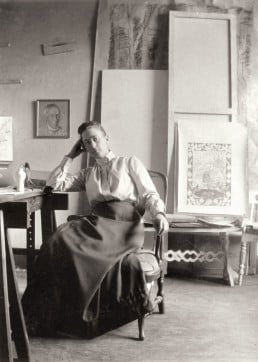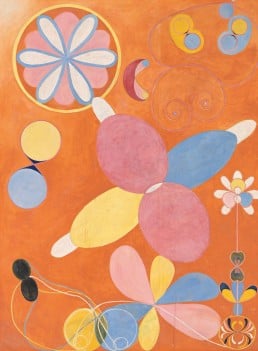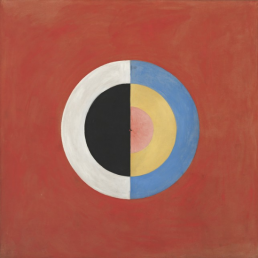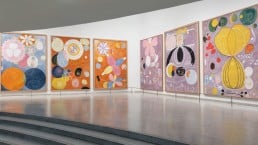
Artland’s Lost (and Found) Artist Series focuses on artists who were originally omitted from the mainstream art canon or largely invisible for most of their careers. The first artist in this series is Hilma af Klint, the mystic Swedish painter and contemporary of famous abstract artists Wasily Kandinsky, Piet Mondriaan, and Kasimir Malevich, who today is being hailed as the very first abstract artist.
Looking back at the history of art, we all know the main stories that dominated the various traditions, movements and periods. Yet history is often written in strange and inconclusive ways and inevitably, important actors are forgotten, ignored, or even invisible, living and working between the cracks of the world around us. Questions such as “Who was the very first abstract artist” permeate art history courses and overviews of art world tendencies, but how can we ever be sure? After all, only a handful of artists managed to get their works out there for all the world to see.
Hilma af Klint is one such artist whose works remained hidden to the eyes of the general public, until now. Af Klint has recently been making waves in the art world, reminding people how important it is to continue to look beyond what is accepted as the established art canon. As early as 1906, the Swedish artist had produced a series of radically abstract paintings, filled with bold colours and shapes unrecognisable in the physical world, while it would take years before her great male contemporaries would start abstracting in their work. Piet Mondriaan’s first abstract works came in 1911, Kasimir Malevich began his journey in 1915 with his “Black Square”, and the publication of Vasily Kandinsky’s 1910 treatise Concerning the Spiritual In Art would mark the beginning of his pull towards abstraction in art. But unlike these artists, Hilma af Klint did not publish manifestoes and promote her art – her motives and ideas were quite different. Af Klint rarely exhibited and stipulated that her works should not be shown until 20 years after her death. She believed that people were not ready for her art yet. What, then, drove her to paint her remarkable opus of abstract works?


Af Klint graduated with honours from Stockholm’s Royal Academy of Fine Arts in 1887, and soon established herself as a respected painter in Stockholm’s artistic circles. At the same time, she became deeply involved in spiritualism and Theosophy, and founded the all-female spiritual circle “De Fem” (The Five) together with four other women. At their weekly meetings, the members of De Fem prayed and meditated together, and held séances in order to communicate with spiritual guides. Spiritualism and Theosophy, at the time, were very much in style in artistic and literary circles in Europe and the United States. The generally accepted “forerunners of abstraction” Malevich, Kandinsky and Mondriaan were all interested and involved in spiritualism as well.

Thanks to the detailed documentation by the five members of De Fem in the notebooks they kept, it is clear that they made successful contact with those before-mentioned spiritual guides. They identified themselves to the women over the years with the names Amaliel, Ananda, Clemens, Esther, Georg and Gregor. In 1904, two of the spiritual guides asked the women to convey the spiritual world through painting and to design a temple for these works. Hilma Af Klint is the only member of De Fem who accepted the task, and after completing purification rituals, she set to work.
Between 1906 and 1908, she completed the first 111 paintings in her vast group of works entitled Paintings for the Temple, which she would finish by 1915. As stated in the Guggenheim’s exhibition description, the paintings are stylistically strikingly diverse, “incorporating both biomorphic and geometric forms, expansive and intimate scales, and maximalist and reductivist approaches to composition and color.” Af Klint imagined placing all 193 works together in a spiral temple, but this never came to be. Instead she decided to keep her works from the public eye until after her death. One of the main reasons for this could be her meeting in 1908 with the famous Theosophist Rudolf Steiner, who was impressed by her paintings yet was wary of the nature of her practice (working as an artist-medium) and told her that no one should see her paintings for at least 50 years. After a break of several years, af Klint returned to painting, and this time her work followed her inner visions instead of the messages from the spiritual guides – a shift that can be observed in the differing styles in her painting.

In later years, af Klint continued to explore and push the boundaries of her abstract explorations in art, experimenting with form, theme, and seriality. She died in 1944, having only exhibited her works a handful of times, mainly at spiritual conferences and gatherings. Her choice to keep her paintings unseen up till 20 years after her death must have come from her deep understanding of the world she was living in. She wanted to make sure that her paintings would be seen by audiences who were ready for them, who would be open to them. She knew that she was far ahead of her time, something that is reflected in the fact that it proved difficult for her descendents to find galleries or museums in the ‘60s and ‘70s who would exhibit her monumental series of works. The breakthrough came in 1986, when her works were shown at the Los Angeles County Museum of Art in an exhibition entitled: “The Spiritual in Art: Abstract Paintings 1890-1985”. And today, as Hilma af Klint’s dazzling paintings are on view in an exhibition at the Guggenheim in New York, she might have finally found something resembling the temple she was meant to build to house her spiritual works. Moreover, it appears that she is also finally receiving her place in the history of art as one of the very first true abstract artists.
“Hilma af Klint: Paintings for the Future” will be on view at the Guggenheim in New York City until April 23rd 2019. The exhibition is curated by Tracy Bashkoff.